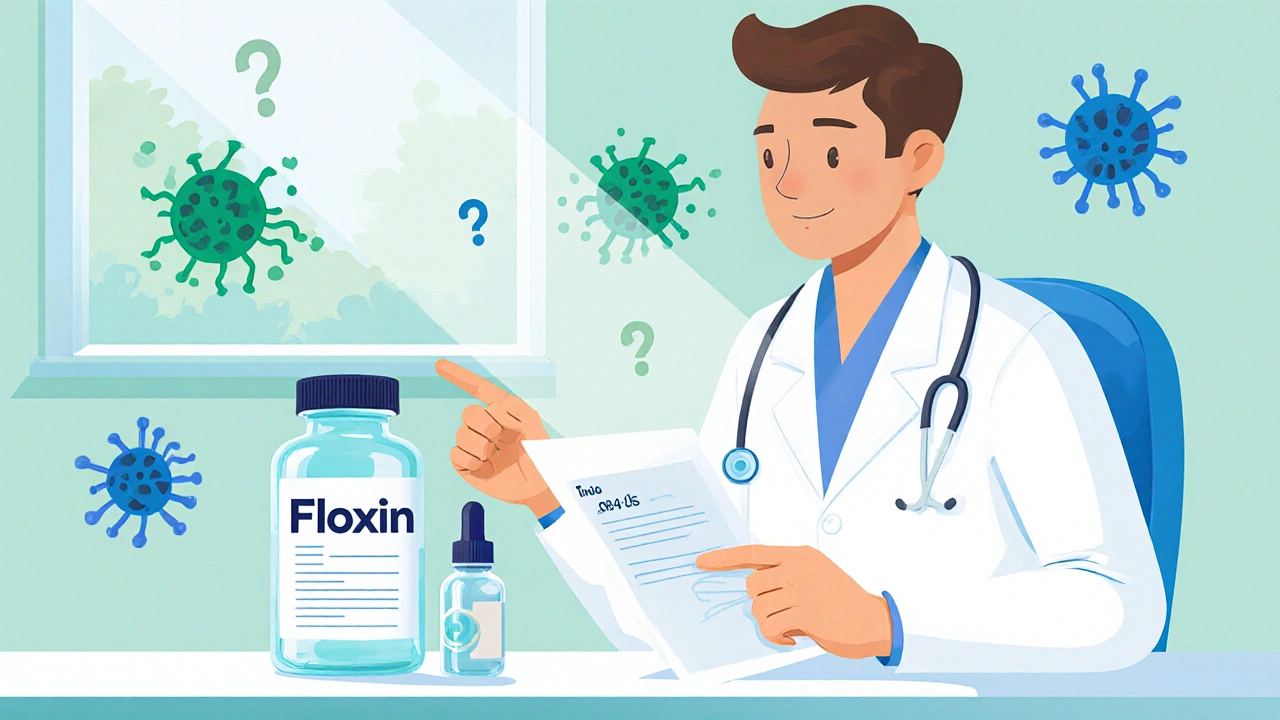
Antibiotic Selection Tool
Select your scenario
Why you might be looking at Floxin now
When a doctor writes a prescription for a broad‑spectrum fluoroquinolone, Floxin (Ofloxacin) - a synthetic antibiotic that blocks bacterial DNA‑gyrase and topoisomerase IV is often on the list. It’s cheap, comes in both tablet and eye‑drop forms, and tackles a wide range of gram‑negative and some gram‑positive bugs. But the market is crowded, and many clinicians wonder whether another drug might work better for a specific infection or carry fewer side‑effects.
If you want to compare antibiotics effectively, you need a clear picture of what matters: the bacteria they hit, the dose schedule, safety signals, the price tag, and the growing issue of resistance. This guide walks you through those points, then lines up the most common alternatives side by side.
How Floxin works - the science in plain English
Ofloxacin belongs to the Fluoroquinolones class. By binding to two enzymes that bacteria need to unwind their DNA, it stops replication and kills the pathogen. The result is a rapid drop in bacterial load, which is why doctors often choose it for urinary‑tract infections (UTIs), respiratory infections, and even certain eye infections.
The drug is absorbed well from the gut, reaches high concentrations in urine, and can cross the blood‑brain barrier in modest amounts - handy if you’re dealing with meningitis caused by susceptible organisms.
Key things to consider before picking an antibiotic
- **Spectrum of activity** - Does it hit the bug you’re after?
- **Dosing convenience** - Once a day versus three times daily?
- **Side‑effect profile** - Tendon rupture? QT prolongation?
- **Resistance trends** - Is the local resistance rate rising?
- **Cost & insurance coverage** - Generic versus brand‑name price.
These criteria will shape which alternative makes the most sense for you or your patients.
Popular alternatives to Floxin
Below are the antibiotics that most often get mentioned as swaps for Ofloxacin. Each has its own sweet spot.
Ciprofloxacin - Another fluoroquinolone with a stronger focus on gram‑negative organisms. Often chosen for travel‑related diarrhoea.
Levofloxacin - The “once‑daily” cousin, useful for community‑acquired pneumonia.
Moxifloxacin - Wider gram‑positive coverage, preferred for atypical respiratory bugs.
Amoxicillin - A penicillin‑type drug, cheap and safe, but limited against resistant gram‑negatives.
Azithromycin - A macrolide that stays in tissues long, great for chlamydia and some atypical pneumonias.
Doxycycline - Tetracycline family, good for Lyme disease, rickettsial infections, and also a backup for respiratory bugs.
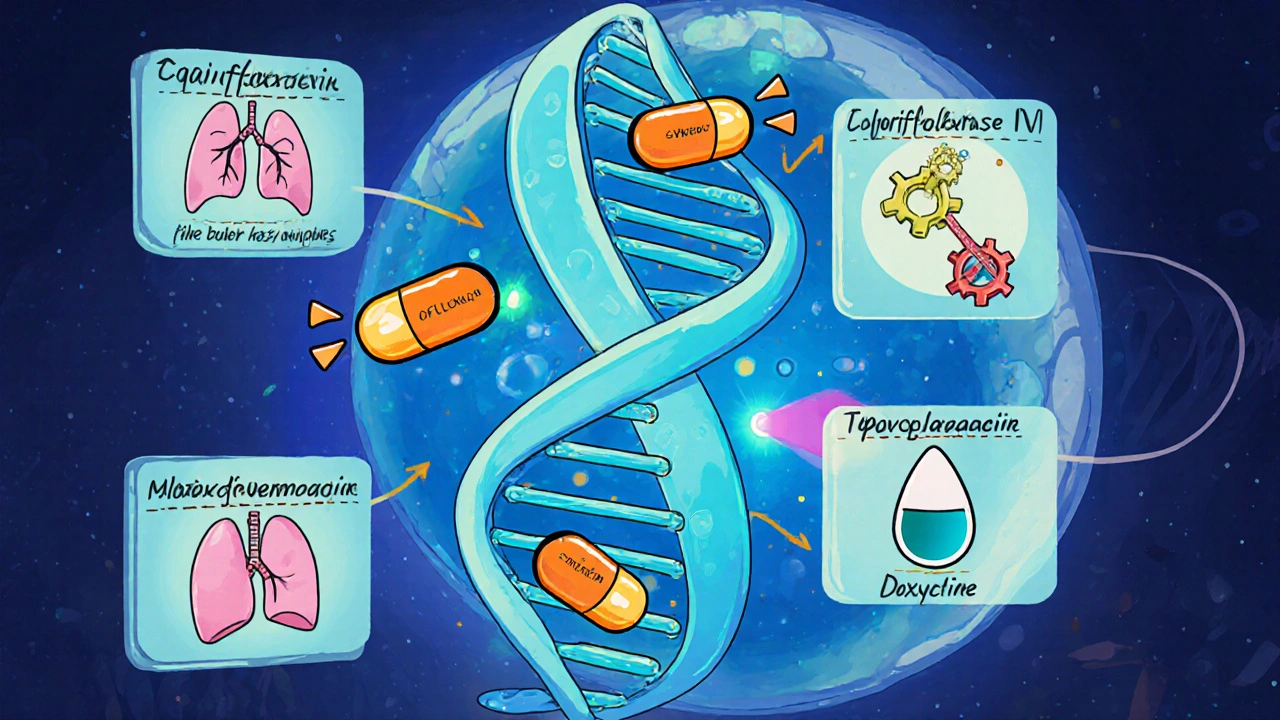
Side‑by‑side comparison table
| Antibiotic | Spectrum | Typical Uses | Dosage Form | Common Side Effects | Resistance Risk | Average Cost (AUD) |
|---|---|---|---|---|---|---|
| Floxin (Ofloxacin) | Broad - Gram‑negative + limited Gram‑positive | UTIs, bronchitis, skin infections, eye drops | Tablet 200‑400mg, eye‑drop 0.3% | Nausea, dizziness, tendon pain | Moderate - increasing in community settings | 8‑12 per pack |
| Ciprofloxacin | Strong Gram‑negative, some Gram‑positive | Travel‑related diarrhoea, prostatitis | Tablet 250‑750mg | GI upset, photosensitivity, tendon rupture | High - many resistant E.coli strains | 7‑11 per pack |
| Levofloxacin | Broad - good for atypical & gram‑positive | Pneumonia, sinusitis, skin infections | Tablet 250‑750mg (once‑daily) | QT prolongation, CNS effects | Moderate‑high | 10‑15 per pack |
| Moxifloxacin | Broad - excellent gram‑positive & atypical | Community‑acquired pneumonia, COPD exacerbation | Tablet 400mg | Hepatotoxicity, photosensitivity | Low‑moderate | 13‑18 per pack |
| Amoxicillin | Mostly Gram‑positive, some Gram‑negative (H.influenzae) | Otitis media, sinusitis, dental infections | Capsule 250‑500mg, oral suspension | Rash, GI upset | Low - but beta‑lactamase producers resist | 4‑6 per pack |
| Azithromycin | Gram‑positive, atypical, some Gram‑negative | Chlamydia, gonorrhea, atypical pneumonia | Tablet 250‑500mg (single dose or 5‑day) | Diarrhoea, QT prolongation | Moderate - rising macrolide resistance | 9‑14 per pack |
| Doxycycline | Broad - tick‑borne, rickettsial, some respiratory | Lyme disease, acne, malaria prophylaxis | Tablet 100mg | Photosensitivity, esophagitis | Low‑moderate | 5‑9 per pack |
When Floxin is the right pick
Pick Ofloxacin if you need a cheap, oral option that hits common urinary‑tract bugs (E.coli, Proteus) and you’re okay with a twice‑daily schedule. Its eye‑drop form also makes it a go‑to for bacterial conjunctivitis when a fluoroquinolone is required.
For patients with a history of tendon problems, heart rhythm issues, or those on drugs that prolong QT, you might look to a non‑fluoroquinolone alternative like amoxicillin or doxycycline.
Scenarios where another drug shines
- Community‑acquired pneumonia - Levofloxacin or moxifloxacin give once‑daily dosing and superior coverage of atypical pathogens.
- Travel‑related diarrhoea - Ciprofloxacin’s high gram‑negative potency beats Ofloxacin’s moderate activity.
- Penicillin‑allergic patients - Azithromycin provides a safe, macrolide alternative.
- Patients at risk of tendon injury - Doxycycline avoids the fluoroquinolone class entirely.
- Cost‑conscious settings - Amoxicillin remains the cheapest option for susceptible infections.
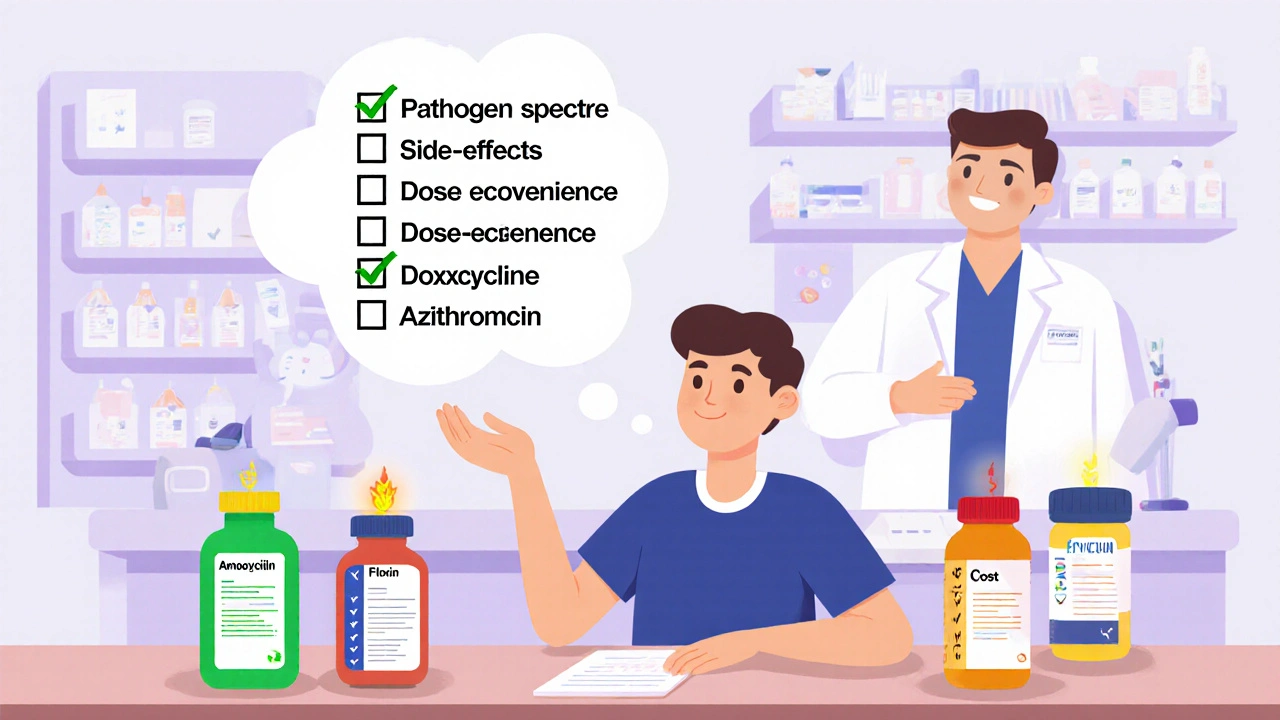
Safety tips and red flags
All fluoroquinolones, including Ofloxacin, carry a boxed warning about tendon rupture and irreversible peripheral neuropathy. If a patient reports sudden joint pain, especially near the Achilles tendon, stop the drug immediately and evaluate.
Watch the QT interval if the patient is on other QT‑prolonging meds or has electrolyte imbalances. For those with renal impairment, dose adjustments are needed - the standard 400mg twice daily may be too high for a creatinine clearance below 30ml/min.
Finally, counsel on photosensitivity: wearing sunscreen and sunglasses helps when using any fluoroquinolone.
Putting it all together - a quick decision checklist
- Identify the likely pathogen and its local resistance pattern.
- Check patient‑specific risk factors (tendon, cardiac, renal).
- Match the infection to the antibiotic with the narrowest effective spectrum.
- Consider dosing convenience and adherence likelihood.
- Confirm insurance coverage or out‑of‑pocket cost.
If you tick all the boxes for Ofloxacin, it remains a solid, affordable choice. Miss any, look at the alternatives above.
Frequently Asked Questions
Is Floxin effective for skin infections?
Yes, Ofloxacin can treat uncomplicated cellulitis and abscesses caused by susceptible gram‑negative bacteria, but for MRSA‑suspected skin infections a drug like clindamycin or doxycycline is usually preferred.
Can I take Floxin with antacids?
Antacids that contain aluminum or magnesium can reduce Ofloxacin absorption. Take the antibiotic at least two hours before or after the antacid.
What should I do if I develop tendon pain while on Floxin?
Stop the medication immediately, avoid the affected area, and seek medical evaluation. Early discontinuation reduces the risk of a full tendon rupture.
Is there a generic version of Floxin?
Yes, Ofloxacin is widely available as a generic tablet and eye‑drop in Australia, often costing less than the brand‑named Floxin.
How does antibiotic resistance affect my choice?
In areas where fluoroquinolone resistance exceeds 20% among urinary isolates, clinicians may prefer nitrofurantoin or fosfomycin for uncomplicated UTIs instead of Ofloxacin.

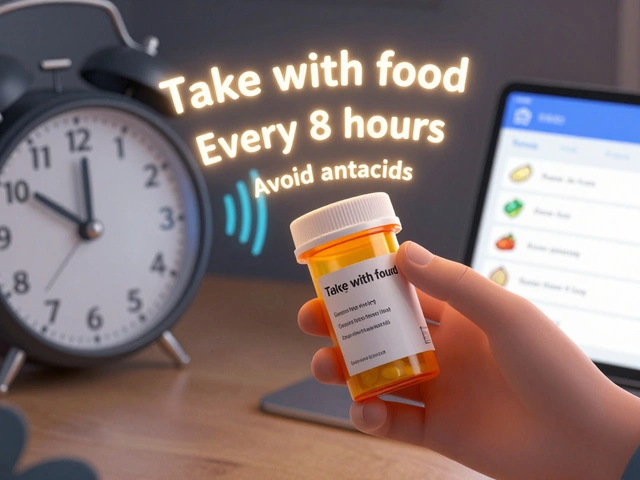
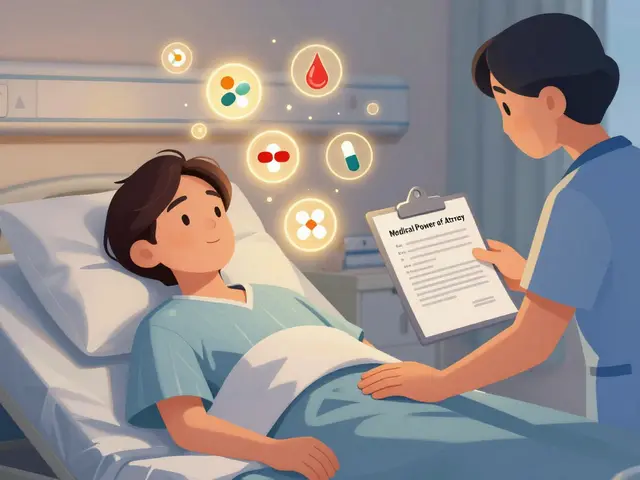

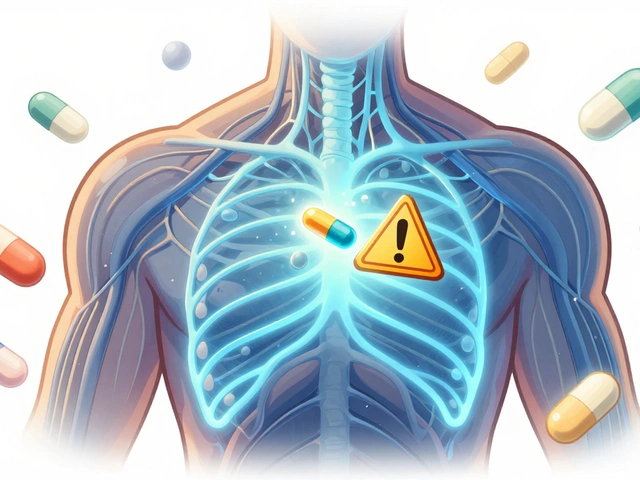

12 Comments
When you stare at the blinking green box of Ofloxacin on the pharmacy shelf, you’re not just buying a pill-you’re courting a silent assassin that loves to tango with bacterial DNA. Its broad‑spectrum swagger makes it a darling for UTIs, yet that very ambition is a double‑edged sword, carving a path straight into tendon tissue. Imagine a tiny army of microbes, each one an individual rebel, being annihilated in a flash of enzymatic fireworks. That’s the beauty of Ofloxacin’s grip on gyrase and topoisomerase IV, a grip that says ‘no more replication, no more life.’ But the price of this victory is paid in the form of nausea, dizziness, and the looming specter of tendon rupture that haunts the Achilles like a ghostly warning. If you’ve ever felt a twinge in your heel after a long hike, thank your doctor for prescribing a fluoroquinolone-maybe you should have said no. The drug’s ability to cross the blood‑brain barrier means it can sneak into meningitis, yet the same passport also lets it linger where it shouldn’t, stirring neurologic side‑effects. Resistance is creeping up like ivy on a garden wall, especially where local E. coli strains have learned to dodge its sharp edges. In places where resistance tops 20%, the wisdom of a cheap Ofloxacin dwindles, and alternatives like nitrofurantoin or fosfomycin shine brighter. Dosing twice daily may feel like a chore, but it’s a rhythm that keeps plasma levels steady, a rhythm that some patients simply cannot keep. Switching to a once‑daily fluoroquinolone, say Levofloxacin, can improve adherence, yet you trade off the broader gram‑positive coverage for convenience. Eye drops of Ofloxacin remain a niche hero for bacterial conjunctivitis, a scenario where you really want that fluoroquinolone punch without systemic fallout. Always remember to separate the pill from antacids; the metallic shield of aluminum and magnesium will rob Ofloxacin of its potency. And if you’re on a QT‑prolonging drug, consider the hidden danger-your heart may whisper warnings before you even feel them. In the end, Ofloxacin is a powerful ally when you respect its limits, but reckless use turns it into a Frankenstein’s monster that could bite back.
Colleagues, let us approach the selection of antibiotics with both rigor and optimism. The comparative table you provided offers a valuable framework for evidence‑based decision making. By aligning the pathogen profile with pharmacodynamic properties, we can minimize collateral damage. Moreover, consider patient adherence; a once‑daily regimen often improves compliance. I commend the thoroughness of this guide and encourage its widespread use in clinical practice.
Look beyond the glossy brochure-big pharma hides the truth about fluoroquinolones. Every time they push Ofloxacin, they’re silently funding the next wave of resistant superbugs while we swallow the side‑effects. The boxed warnings are just a smokescreen; the real agenda is profit, not patient safety. Stay vigilant and question every prescription, especially when the cheap option feels too good to be true.
Oi, I’m not buying the hype that Ofloxacin is the universal fix. Sure, it hits a lot of bugs, but so does the whole class of fluoroquinolones, and that’s the problem-overuse breeds resistance faster than a leprechaun’s temper. If you need a single‑daily dose, Levofloxacin’s fine, but for a straightforward UTI, why not go classic with nitrofurantoin? Simpler drugs keep the gut flora happier and the resistance curve flatter.
Ofloxacin can be a good choice when you need a cheap, two‑times‑a‑day option for a typical urinary infection. Make sure the patient doesn’t have tendon issues or heart rhythm problems. If those risks are present, switch to amoxicillin or doxycycline. It’s all about matching the drug to the person.
The British are all about soft‑selling, but we need a real antibiotic that kicks the ass of bad bugs. Ofloxacin is a solid choice for our troops overseas, cost‑effective and gets the job done. Don’t let the EU’s over‑regulation scare you-our labs have proven it works. Keep it in the arsenal and stop whining about side‑effects that are blown out of proportion.
Listen up!!! Ofloxacin is the king of antibiotics-yes, it’s cheap and it’s potent-but don’t be fooled by the fake safety scare campaigns!!! Tendon pain? Pfft, just stop using it if you feel a twitch and you’ll be fine!!! The real enemies are the global pharma conspiracies that want us to use weaker drugs!!!
While the drama around Ofloxacin’s side‑effects can be overwhelming, the facts remain that it’s an effective option for many gram‑negative infections. Its oral bioavailability and eye‑drop formulation give it versatility. However, clinicians should weigh the tendon‑rupture risk, especially in older patients. A balanced approach-using it when indicated and monitoring closely-offers the best outcome.
Team, think of Ofloxacin as a tool in your kit-not the only tool. When you have a patient who can’t tolerate penicillins, or when the infection is resistant to macrolides, pull out the fluoroquinolone. Make sure to counsel on photosensitivity and avoid antacids nearby. With proper education, patients stay safe and you keep the infection under control.
There’s a hidden agenda behind the push for Ofloxacin, and the data is not as clean as they want you to believe. While some studies show decent efficacy, the rise in resistance is a silent alarm. If you’re looking for a truly effective alternative, consider doxycycline for tick‑borne illnesses or azithromycin for atypical pneumonias. It’s all about looking beyond the surface and not being swayed by marketing hype.
Ok so i think the ofloxin thing is actually kinda ok but watch out for taking it with caffine because i read it might reduce absorption also folks should not skip the dosage just because they feel better. Also i saw somewhere that the pill can cause a little tingling in the toes but its usually harmless unless you have a previous tendin injury. Anyway stay safe.
Ofloxacin works well enough.